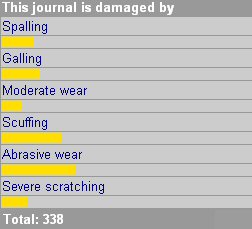|
|
 |
|
Some support bearings of rocker arms sequentially show severe wear damage indicated by scuffing. Oil analysis where performed to determine the condition of the engine oil. The oil analysis report gave a lack of anti scuff (EP) additives. In order to prevent this type of damage oil analysis when used as part of a routine program might be effective.
EP additives typically adhere onto the metal
surface by adsorbing either by physical or chemical attraction. Where
asperities come into contact under boundary lubrication conditions,
high (flash) temperatures in the micro contacts initiate the additives
to form a protective layer by chemical reaction with the metal
surface. |
|
|
|
|
